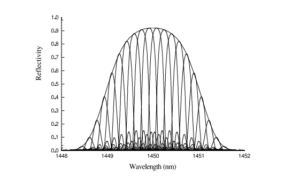 Fiber Bragg Gratings is one of the most meaningful developments in the areas of optical fiber technology, due to their flexibility and unique filtering performance. FBG is defined as the key component in dense wavelength division multiplexing on the basis of their low insertion loss, high wavelength selectivity, low polarization dependent loss, and low polarization modal dispersion.
Fiber Bragg Gratings is one of the most meaningful developments in the areas of optical fiber technology, due to their flexibility and unique filtering performance. FBG is defined as the key component in dense wavelength division multiplexing on the basis of their low insertion loss, high wavelength selectivity, low polarization dependent loss, and low polarization modal dispersion.
When light propagates through the FBG in the narrow range of wavelength, the total internal reflection appears at Bragg wavelength and other wavelengths don`t have influence by the Bragg grating except some side lobes existing in the reflection spectrum. These side lobes are sometimes interfering, e.g. in some applications of fiber Bragg gratings as optical filters. They can be largely brought out with the technique of apodized FBG: the strength of the index modulation is smoothly ramped up and down along the grating.
The term apodization is concerned with the grading of the refractive index to approach zero at the end of the grating. Apodized gratings introduce the essential improvement in side-lobe suppression while maintaining reflectivity and narrow bandwidth. Gaussian and raised cosine methods are typically used to apodize an FBG. Each method has some special features and different methods of fabrication. The fabrication of apodized Gaussian Bragg gratings is using the two UV-pulse interfere with variable time delay, which strongly reduces the reflectivity at sidelobes and this method makes it possible to write off truly apodized gratings by the single exposure of a uniform phase mask.
The fabrication of Apodized Fiber Bragg Gratings has raised much interest because of its reduced reflectivity at sidelobes. It, therefore, increases the quality of optical filters and improves the dispersion compensation by simultaneously reducing the group delay ripples. Apodized FBG can be used to optimize the parameters of the introduced optical switch and may also prove to be useful as the optical sensing element in a range of other fiber sensor configurations, especially for grating-based chemical sensors, pressure sensors, and accelerometers.

